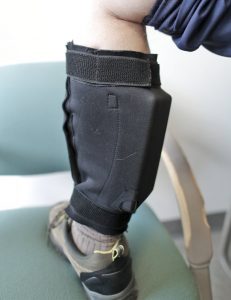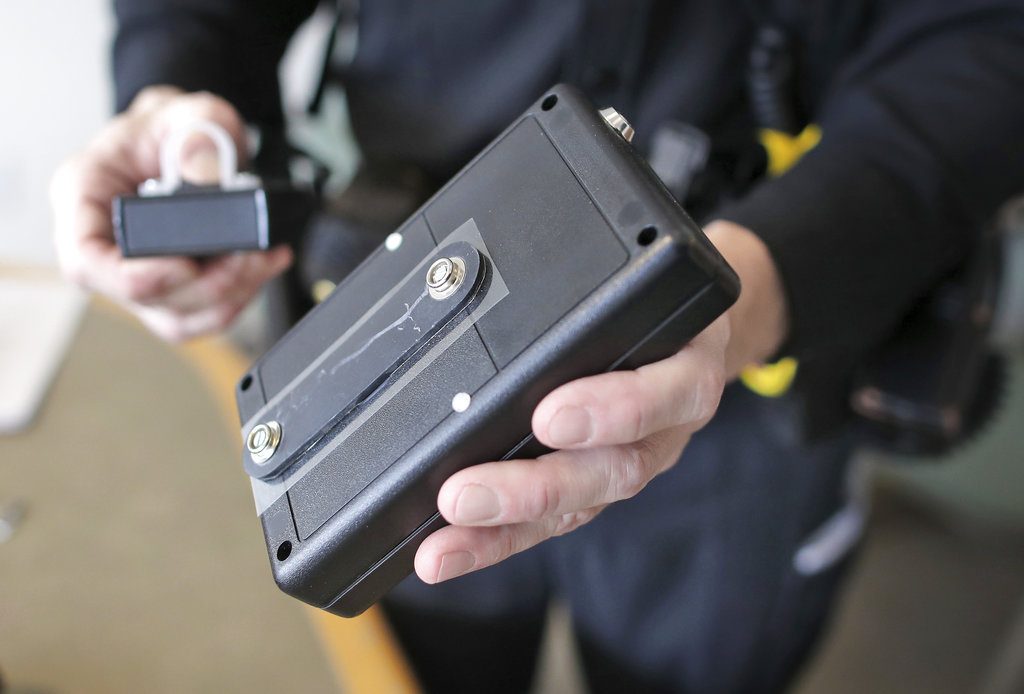Counties using stun cuff to control inmates at trial
By: Associated Press//February 19, 2018//
By FRANK SCHULTZ
Janesville Gazette

JANESVILLE, Wis. (AP) — Deputy Bryan Hanthorn is one of the few people who has worn a stun cuff and experienced the 50,000 volts the device can deliver.
Hanthorn said the jolt focuses the mind on one thing only: how to get the device off.
Hanthorn had it strapped to his arm, but it’s usually fastened to the legs of defendants.
“It locked my whole arm up, every muscle group in my forearm and arm was locked. It froze me, and it got me up on my tippy toes,” Hanthorn told the Janesville Gazette . “It’s discomfort, but I wouldn’t say it’s like pain.”
The cuff is strapped onto defendants’ ankles during jury trials in Rock and Walworth counties to provide control over inmates without tipping off jurors that defendants are in custody, officials said.
Rock County uses a model called a Band-It. Walworth County uses the Stun-Cuff, which is said to deliver 80,000 volts.
The 50,000 volts is the same as that delivered by a police officer’s Taser, Hanthorn noted.
What is a stun cuff?
Like a Taser, the stun devices deliver very low amperage, which prevents any lasting damage.
“It’s a voltage that’s safe to a human. Now, that’s not to say someone’s not going to have a medical problem from it,” Hanthorn said.
Some other jurisdictions might use the cuffs for transporting prisoners thought to be particularly dangerous, but not here, said Hanthorn and Sgt. Brian Panfil of the Walworth County Sheriff’s Office.
The shock devices were first used in Walworth County, and Rock County adopted them about eight years ago, Hanthorn said.
Rock County recently bought a back-up Band-It at a cost of $940.
The Gazette found out about the device during the recent trial of Joseph Jakubowski, who burglarized a local gun shop last April. At the start of the Jakubowski’s trial, Judge James Daley ordered news media not to photograph Jakubowski below the waist.
The cuff was hidden under Jakubowski’s pant leg, but the outline of a rectangular box — about 8 inches long by 3 inches wide — could be seen.
Jakubowski didn’t wear the cuff because he was more dangerous than other defendants. He wore it because all in-custody defendants wear them during jury trials, officials said.
For all other court appearances, Rock County Jail defendants wear leg shackles connected to handcuffs by a chain passed through a ring on a leather belt.
Courts want to keep juries from finding out that a defendant — who is innocent until proved guilty — is being held at the jail.

The thinking is that jury members would tend to think defendants, who are dressed in civilian clothes for jury trials, are guilty if they see them in chains.
Use of the cuffs is a decision of the sheriff’s office, whose job is court security. A deputy close to the defendant typically holds a remote-control device, Hanthorn said. The deputy has to insert his finger under a plastic guard to push the button.
A short push activates a high-pitched beep to warn the defendant. A long push on the button delivers the shock.
The volts flow through two metal buttons about 3 inches apart on the defendant’s skin.
When activated, the device gives off a loud crackling sound similar to that of hand-held, electric, self-defense devices available commercially.
A Maryland judge was removed from the bench last year for ordering a deputy to activate a Stun-Cuff on a defendant who would not stop talking after the judge ordered him to stop. The defendant screamed and fell to the floor, as seen in a video obtained by ABC News.
The judge was found guilty of a misdemeanor civil-rights violation. He was ordered to pay a $5,000 fine and take anger-management class.
But that’s not how things work here, Hanthorn said. The decision to activate the cuff is up to deputies.
No defendant in Rock County has ever been shocked in court, and the warning tone has never been used, either, Hanthorn said.
Walworth County’s Panfil said he has never seen the cuff used in his three years on the job, and others who have worked in the courts for 10 year told him they have never seen it used.
“Once we explain what it can do, most people are pretty well behaved,” Hanthorn said.
Both counties use a notification form that the inmate and deputies sign. The Rock County form says the inmate is being required to wear “an electronic immobilization system” that can potentially cause: self-defecation, self-urination and immobilization.
The form goes on to say that a deputy with a remote control will activate it if the defendant makes any outburst or quick movement, hostile movement, tampers with the system, tries to escape, anytime a designated deputy can’t see the defendant’s hands and “any overt act against any person within 50 feet of the defendant.”
The Public Leadership Institute, which describes itself as a nonprofit, nonpartisan organization that raises awareness on issues of equity and justice, has proposed a model law to prohibit such devices.
The institute cites an Amnesty International report and European Union regulations that ban trade in such devices.
“Even when such electric-shock ‘restraints’ are worn by humans but not activated, they may constitute cruel, inhuman or degrading treatment, maintaining prisoners in constant fear of instant pain for as long as they are worn,” the report states.
Bernie Horn, the institute’s senior director for policy and communications, said alternatives exist that do not involve what he sees as torture devices.
A defendant can be seated in the courtroom before the jury enters and be chained to a desk in a way the jury can’t see, Horn suggested.
“It’s very likely to be used in an abusive way if it’s available,” Horn said. “Somebody wants to make a buck, and police like to have the latest gadget.”
Myers Enterprises, which makes the Stun-Cuff, states on its website: “Today’s criminal is hardened, desperate and more dangerous than ever. … They are out of control! … You can’t allow a murder suspect freedom in the courts, filled with innocent bystanders where they may attempt to break free. … Whether taking a prisoner for a doctor visit, transporting them for trial, interrogations or dealing with a prisoner that is under the influence. They must be controlled.”
StunTronics, which makes the Band-It device, said “It’s been used on tens of thousands of prisoners nationwide by local and federal law enforcement agencies, including the Federal Bureau of Prisons and the U.S. Marshals Service.”
Rock and Walworth counties use the cuffs only during trials, but Horn said this still constitutes torture, and even if the defendants are never zapped, the threat of being shocked is psychological torture.
Panfil said he has never heard a complaint from defense attorneys. Hanthorn said he has never heard of any attempt to sue the county for using the device.
Hanthorn said Rock County formerly used a “lockout brace” that fastens on the knee and restricts movement. It poses a risk of injury, and that’s why the Band-It was adopted after a search for alternatives, Hanthorn said.
Lockout braces are still used to transport inmates on airplanes when shackles are prohibited, Hanthorn said.
StunTronics, meanwhile, said its Band-It device has produced no deaths or serious injuries.
Legal News
- Gov. Evers seeks applicants for Dane County Circuit Court
- Milwaukee man charged in dismemberment death pleads not guilty
- Democratic-led states lead ban on the book ban
- UW Madison Professor: America’s child care crisis is holding back moms without college degrees
- History made in Trump New York trial opening statements
- Prosecutor won’t bring charges against Wisconsin lawmaker over fundraising scheme
- Republican Wisconsin Senate candidate says he doesn’t oppose elderly people voting
- Vice President Harris to reveal final rules mandating minimum standards for nursing home staffing
- Election workers fear threats to their safety as November nears
- Former law enforcement praise state’s response brief in Steven Avery case
- Eric Toney announces re-election bid for Fond du Lac County District Attorney
- Former Wisconsin Democratic Rep. Peter Barca announces new bid for Congress
WLJ People
- Power 30 Personal Injury Attorneys – Russell Nicolet
- Power 30 Personal Injury Attorneys – Benjamin Nicolet
- Power 30 Personal Injury Attorneys – Dustin T. Woehl
- Power 30 Personal Injury Attorneys – Katherine Metzger
- Power 30 Personal Injury Attorneys – Joseph Ryan
- Power 30 Personal Injury Attorneys – James M. Ryan
- Power 30 Personal Injury Attorneys – Dana Wachs
- Power 30 Personal Injury Attorneys – Mark L. Thomsen
- Power 30 Personal Injury Attorneys – Matthew Lein
- Power 30 Personal Injury Attorneys – Jeffrey A. Pitman
- Power 30 Personal Injury Attorneys – William Pemberton
- Power 30 Personal Injury Attorneys – Howard S. Sicula











